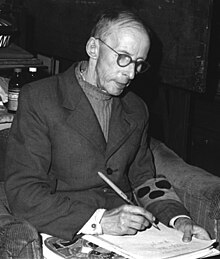Harry disk
Harry Gebhard Martin Scheibe (born April 22, 1897 in Weimar ; † January 30, 1979 there ) was a German typesetter , writer and philosopher (the so-called "Bauhaus philosopher ").
life and work
Harry Scheibe was born in Weimar in 1897. His father Ernst Scheibe was a court lithographer and ran a book and lithographic printing company, a publishing house, a bookbindery and, with his wife, a stationery shop. After attending elementary school and high school, Harry Scheibe completed an apprenticeship as a typesetter in his father's company. From 1916 to 1918 he was drafted into the First World War.
Back in Weimar, he pursued intensive philosophical studies, as he had done since he was young, frequented artistic circles and kept himself afloat with odd jobs. An encounter with Karl Peter Röhl in 1919 marked the beginning of intensive contacts with the Bauhaus and the resulting temporary collaboration with Theo van Doesburg . With Röhl, Max Burchartz , Walter Dexel , Werner Graeff and Andor Weininger , Scheibe belonged to the Weimar De Stijl group. From 1921 to 1923 he translated lectures, essays and teaching material from Dutch into German especially for van Doesburg, but also for J. J. P. Oud , and helped translate the basic concepts of the new creative arts . In 1922 he was a participant in the International Congress of Constructivists and Dadaists in Weimar. In 1926 he wrote his well-known essay The Atmosphere of the New Architecture and the Filosofian Swoops . During this time he developed a closer friendship with the artist Lena Maas .
After the Bauhaus moved to Dessau , he continued to meet former Bauhaus members such as Heinrich Brocksieper and Weimar artists such as Alfred Ahner , Bruno Voigt, Martin Pohle and Harry Schmidt-Schaller. In the 1930s he became increasingly hard of hearing, suffered from mental illness as a result of hostility and became more and more lonely. From 1939 to 1948 he was housed in various sanatoriums and nursing homes ( Blankenhain , Stadtroda , Rastenberg ) and sterilized in Stadtroda in 1941 for reasons of racial hygiene.
In a Feierabendheim alive again in Weimar, he had a close friendship with the Weimar graphic artists, printers, poets and philosophers since the early 1950s, Arno Fehringer . Up until his death in 1974, a number of joint works were created as part of a regular philosophical exchange of ideas, which dealt with contemporary history and the role of knowledge and action in shaping society. A long-planned book about the Bauhaus never came about because almost all of his records were lost in the turmoil of the years.
Fonts
- The atmosphere of the new architecture . In: Die Form, Vol. 1, 1925/26, Issue 13, pp. 329–331 ( digitized version ).
literature
- Constanze Hofstaetter: Karl Peter Röhl and the modern age . Michael Imhof Verlag, Petersberg 2007, ISBN 978-3-86568-088-4 .
- Wies van Morsel: Average is not enough! Nelly van Doesburg 1899-1975 . Niggli Verlag, Sulgen / Zurich 2003, ISBN 3-7212-0493-X .
- Lothar Kühne : Object and Space (= Fundus series . Volume 77/78 ). VEB Verlag der Kunst, 1981, ZDB -ID 254005-8 ( mxks.de [ Rich Text Format gzip ; 310 kB ; accessed on January 25, 2018]).
- Eckhard Neumann (Ed.): Bauhaus and Bauhäusler - Memories and Confessions. DuMont Buchverlag, Cologne 1985, ISBN 3-7701-1673-9 .
- Christian Tesch, Ulrich Völkel (Ed.): Small Lexicon Bauhaus Weimar . wtv Weimarer Taschenbuch Verlag, Weimar 2010, ISBN 978-3-939964-14-8 .
- Christina Ada Anders (Ed.): For the time being I have to stay alive. Alfred Ahner - from the letters and diaries of the Weimar artist (1890–1973) . Georg Olms Verlag, Hildesheim / Zurich / New York 2014, ISBN 978-3-487-08551-7 .
- Wolfgang Thiede: Bruno Voigt 1912–1988, Resistance Art 1933–1944 . AGO gallery, Berlin 1988, ISBN 978-3-927415-00-3 .
Individual evidence
- ↑ Dunja Schneider: word spaces . LIT Verlag Dr. W. Hopf, Berlin 2011, ISBN 978-3-643-10764-0 .
- ^ Theo van Doesburg: Basic concepts of the new creative art (= Bauhaus books . Volume 6 ). Albert Langen Verlag, Munich 1925.
- ↑ Bernd Finkeldey (Ed.): Constructivist International Creative Working Group, 1922–1927, Utopias for a European Culture . Catalog for the exhibition, Düsseldorf, Halle / Saale 1992, ISBN 978-3-7757-0376-5 .
- ^ Walter Curt Behrend (Ed.): Die Form - magazine for creative work . 1st year / issue 15. Verlag Hermann Reckendorf, Berlin December 1926, p. 329-331 .
- ↑ Harry Scheibe: From the meaning and reason of life - Filosofische swoops . Unpublished (estate of Arno Fehringer). 1926.
- ↑ State Archive Thuringia - State Archive Rudolstadt: State Hospital for Psychiatry and Neurology Stadtroda . No. 3110 .
- ↑ Arno Fehringer, Harry Scheibe: The brilliant solution of our overall knowledge (Goethe - Leibniz) . Unpublished (estate of Arno Fehringer). 1967.
- ↑ Arno Fehringer, Harry Scheibe: Quintessence and Quintessence II . Unpublished (estate of Arno Fehringer). 1969.
| personal data | |
|---|---|
| SURNAME | Disk, Harry |
| ALTERNATIVE NAMES | Scheibe, Harry Gebhard Martin (full name) |
| BRIEF DESCRIPTION | German typesetter, writer and philosopher |
| DATE OF BIRTH | April 22, 1897 |
| PLACE OF BIRTH | Weimar |
| DATE OF DEATH | January 30, 1979 |
| Place of death | Weimar |
